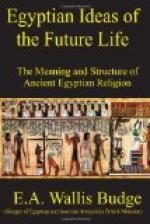The existence of the non-historic inhabitants of Egypt has been revealed to us in recent years by means of a number of successful excavations which have been made in Upper Egypt on both sides of the Nile by several European and native explorers, and one of the most striking results has been the discovery of three different kinds of burials, which undoubtedly belong to three different periods, as we may see by examining the various objects which have been found in the early graves at Nak[=a]dah and other non-historic sites of the same age and type. In the oldest tombs we find the skeleton laid upon its left side, with the limbs bent: the knees are on a level with the breast, and the hands are placed in front of the face. Generally the head faces towards the south, but no invariable rule seems to have been observed as to its “orientation.” Before the body was laid in the ground it was either wrapped in gazelle skin or laid in loose grass; the substance used for the purposes of wrapping probably depended upon the social condition of the deceased. In burials of this class there are no traces of mummification, or of burning, or of stripping the flesh from the bones. In the next oldest graves the bodies are found to have been wholly or partly stripped of their flesh; in the former case all the bones are found cast indiscriminately is the grave, in the latter the bones of the hands and the feet were laid together, while the rest of the skeleton is scattered about in wild confusion. Graves of this period are found to be oriented either north or south, and the bodies in them usually have the head separated from the body; sometimes it is clear that the bodies have been “jointed” so that they might occupy less space. Occasionally the bodies are found lying upon their backs with their legs and arms folded over them; in this case they are covered over with clay casings. In certain graves it is clear that the body has been burnt. Now in all classes of tombs belonging to the prehistoric period in Egypt we find offerings in vases and vessels of various kinds, a fact which proves beyond all doubt that the men who made these graves believed that their dead friends and relatives would live again in some place, of the whereabouts of which they probably had very vague ideas, in a life which was, presumably, not unlike that which they had lived upon earth. The flint tools, knives, scrapers and the like indicate that they thought they would hunt and slay their quarry when brought down, and fight their foes; and the schist objects found in the graves, which M. de Morgan identifies as amulets, shows that even in those early days man believed that he could protect himself against the powers of supernatural and invisible enemies by talismans. The man who would hunt and fight in the next world must live again; and if he would live again it must be either in his old body or in a new one; if in the old body, it must be revivified. But once having imagined a new life, probably in a new body, death a second time was not, the prehistoric Egyptian hoped, within the bounds of possibility. Here, then, we have the origin of the grand ideas of the RESURRECTION and IMMORTALITY.




